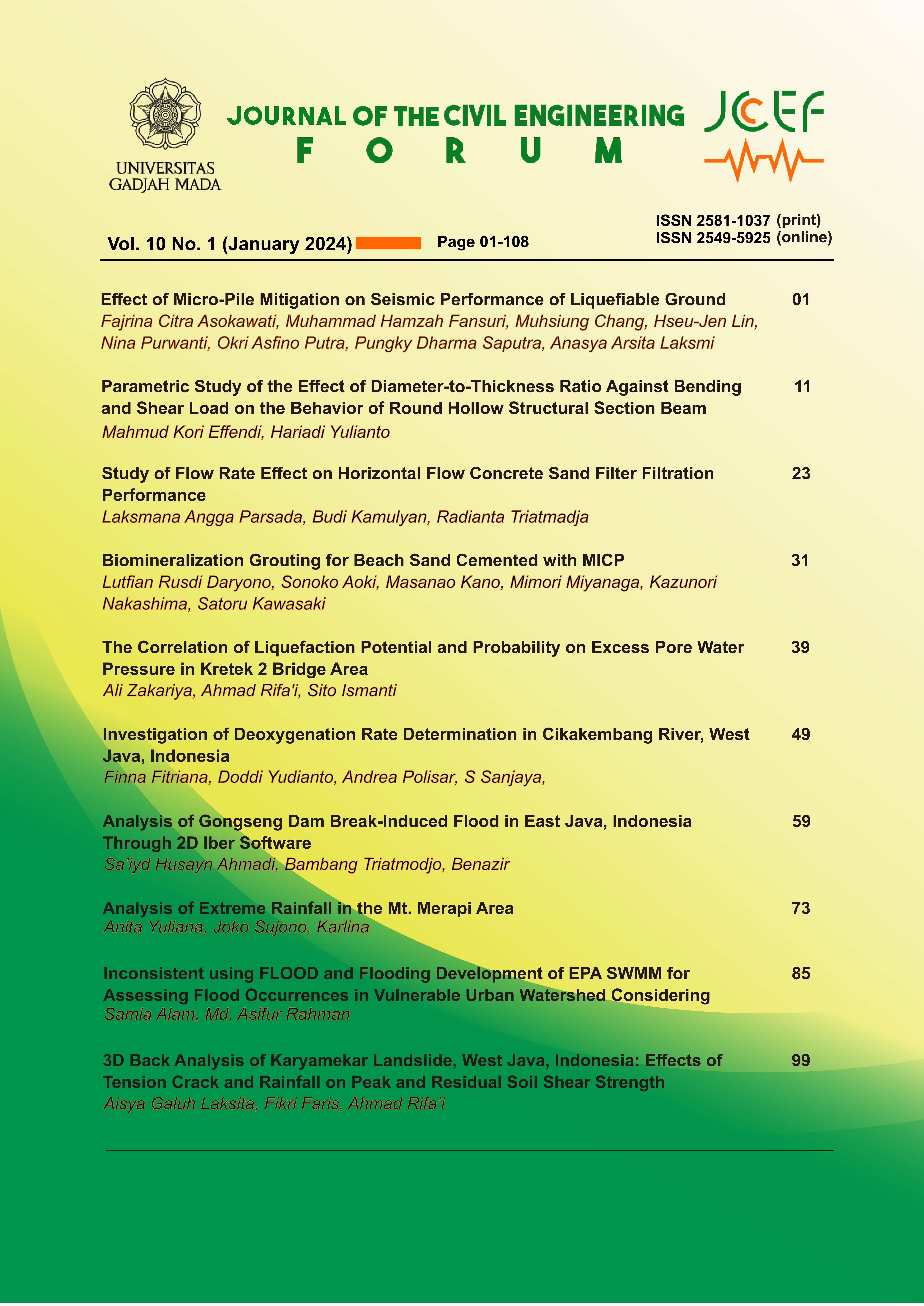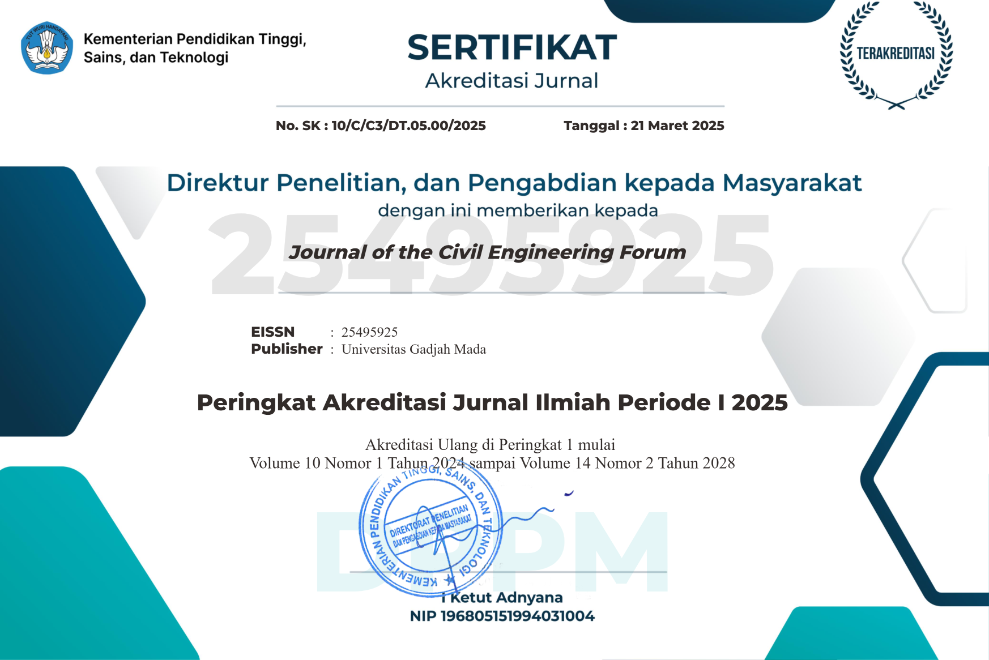Parametric Study of the Effect of Diameter-to-Thickness Ratio Against Bending and Shear Load on the Behavior of Round Hollow Structural Section Beam
Abstract
The steel-constructed buildings in Indonesia are on the rise, indicating a growing preference for their durability and versatility in construction projects. This led to the general application of Round Hollow Structural Section (Round HSS) as column and beam elements. Therefore, this study aimed to conduct parametric analysis of the effect of Diameter-to-Thickness Ratio (D t-1) on the three-point and four-point flexural analysis of Round HSS beam using MSC Marc/Mentat software. Nonlinear materials and geometries were employed, along with the application of contact analysis, with contacted and contacting bodies. Moreover, the load and boundary condition were set to be similar to the experiment. The results showed that a greater D t-1 led to the possibility of withholding a smaller load and causing smaller displacement in Group A with fixed diameter and different thickness values. Meanwhile, in Group B with fixed thickness but different diameters, a greater D t-1 led to the potential of restraining more load and experiencing smaller displacement. All specimens from both groups were observed to have failed due to a combination of global and local buckling at the right location under the load applied. AISC bending moment calculated was found to be greater than the values obtained from the finite element analysis for all sections under three-point loads. It was also discovered in the four-point flexural analysis that the bending moment of noncompact section was greater than for AISC while those for the compact section were lower. Furthermore, shear strength (Vn) calculated was observed to be greater than
shear force from finite element analysis (Pmax/2).
References
AISC (2022), ANSI/AISC 360-22, Specification for Structural Steel Buildings, Chicago AISC.
AISC,A. I. o. S. C. (2005), Steel Construction Manual.
AISC360, A. I. o. S. C. (2016), Specification for Structural Steel Buildings.
AS4100, S. A. (2020), Steel Structures.
BS (2006), Eurocode 3—design of steel structures—, Technical report, BS EN 1993-1, 1, p.2005.
BSN, B. S. N. (2020), SNI 1729: 2020 Spesifikasi Untuk Bangunan Gedung Baja Struktural, Jakarta.
Chan, T. and Gardner, L. (2008), ‘Bending strength of hot-rolled elliptical hollow sections’, Journal of Constructional Steel Research 64(9), 971–986.
Effendi, M., Kawaguchi, H., Minami, K. and Kawano, A. (2015), ‘An analytical study on effect of loading tip shapes on flexural behavior of vacant and concrete-filled steel tubular members subjected to concentrated transverse loads’, Kou kouzou rombunshuu 22(86), 8633–8645.
Effendi, M., Zaitsu, S., Kawaguchi, H., Kawano, A., Matsuo, S., Tsuda, K. and Kido, M. (2014), ‘Finite element analysis of vacant tubular members under static loading considering the tip shapes of load’, Applied Mechanics and Materials.
Elchalakani, M., Zhao, X. and Grzebieta, R. (2002), ‘Bending tests to determine slenderness limits for cold-formed circular hollow sections’, Journal of Constructional Steel Research 58(11), 1407–1430.
Gardner, L. and Chan, T. (2007), ‘Cross-section classification of elliptical hollow sections’, Steel and Composite Structures 7(3), 185.
Guo, L., Yang, S. and Jiao, H. (2013), ‘Behavior of thin-walled circular hollow section tubes subjected to bending’, Thin-Walled Structures 73, 281–289.
Jiao, H. and Zhao, X.-L. (2004), ‘Section slenderness limits of very high strength circular steel tubes in bending’, Thin-Walled Structures 42(9), 1257–1271.
Kamruzzaman, M., Jumaat, M., Sulong, N., Qeshta, I. and Narmashiri, K. (2017), Effects of lateral bracing and stiffeners on the cfrp failure of strengthened steel beams, in ‘IOP Conference Series: Materials Science and Engineering’, IOP Publishing, p. 12021.
Mahamid, M. (2020), Design Of Steel And Composite Members. Structural Engineering Handbook, Fifth Edition.
MSC (2003), MSC Software corporation, Santa Ana, CA.
MSC, . S. C. (2010), Volume B: Element Library.
Niroomandi, A., Pampanin, S., Dhakal, R. and Soleymani Ashtiani, M. (2015), Comparison of alternative assessment procedures to predict seismic performance of rc columns, in ‘Proceedings of tenth Pacific conference on earthquake engineering’, Sydney, Australia.
Sherman, D. (1986), Inelastic flexural buckling of cylinders, in M. Pavlovic, ed., ‘Steel Structures: Recent Research Advances and Their Applications to Design’, Elsevier Applied Science Publishers, p. 339–357.
SIA265, S. S. A. (2012), Timber structures.
Zhu, J.-H., Su, M.-N., Zhu, X., Daniels, J. and Young, B. (2021), ‘Flexural behaviour of coldformed steel oval hollow section beams’, Journal of Constructional Steel Research 180, 106605.
Copyright (c) 2024 The Author(s)

This work is licensed under a Creative Commons Attribution-ShareAlike 4.0 International License.
Copyright is granted to authors for the purpose of providing protection for articles written to describe experiments and their results. JCEF will protect and defend the work and reputation of the author and are also willing to address any allegations of violation, plagiarism, fraud, etc. against articles written and published by JCEF. JCEF is published under the terms of the Creative Commons Attribution-ShareAlike 4.0 International License (CC BY-SA 4.0). The author holds the copyright and assigns the journal rights to the first publication (online and print) of the work simultaneously.







